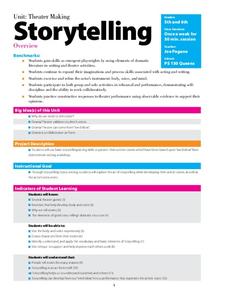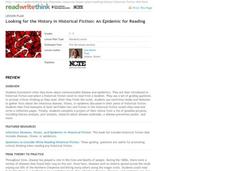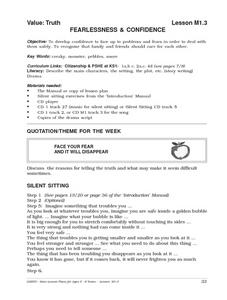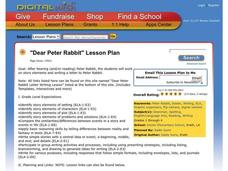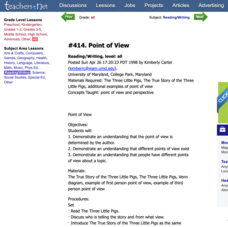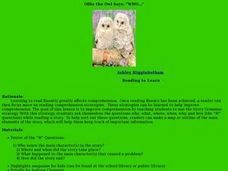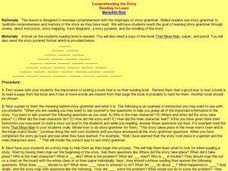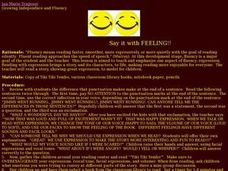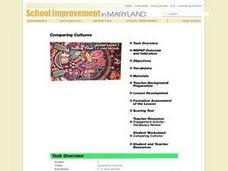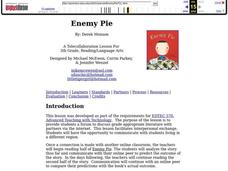John F. Kennedy Center
Writing a Myth
Tap into the imaginative minds of young learners with a creative writing activity. After reading the myth Giants and Mosquitoes, this student guide supports young writers as they brainstorm and develop their very own creation myths....
New York City Department of Education
Theater Units for Lower and Upper Elementary Levels
Introduce middle schoolers to playwriting and the elements of drama with a six-session storytelling unit that encourages kids to expand their acting and writing skills. The 12-page packet includes overviews of the lessons,...
ReadWriteThink
Looking for the History in Historical Fiction: An Epidemic for Reading
Combine informational reading skills with fictional text in an innovative historical fiction lessons. After reading a fictional text related to diseases, class members read non-fictional text to gain knowledge about specific infectious...
Curated OER
Amos and Boris: Text Study
Twenty insightful questions follow a read aloud of the story, Amos and Boris by William Steig. Scholars then show what they know through completion of a cause and effect chart, reading fluency assessment, and a written...
Museum of Tolerance
Immigration Journeys
Through the journey of four stories of immigration, scholars complete graphic organizers and apply knowledge to create a visual representation of their findings on a large poster. Third and fourth readers write a letter to their...
ESL Kid Stuff
Halloween
Build vocabulary and get in the Halloween sprit with a collection of festive activities! Here, scholars take part in a holiday celebration, unearth the unknown in mystery feel-boxes, and create monster masks out of paper plates.
Curated OER
Fearlessness and Confidence
Students develop confidence to face up to problems and fears in order to deal with them safely. They recognize that family and friends should care for each other. Students go through a series of activities that they interact with,...
Curated OER
Telling a Story
Young scholars create a story about a picture. For this writing lesson, students select a picture and write a story about what happened in the picture. Young scholars are encouraged to write a story with a beginning, middle, and end.
Curated OER
Summarizing Key Information
Imagine the surprise when small groups present their Evidence Charts to the class and discover that each group has studied a different version of the Cinderella story. Irish, Ojibwa, Egyptian, Chinese, Korean, Persian, Mexican, and...
Curated OER
Dear Peter Rabbit
Write dear old Peter Rabbit a letter with this lesson. First, youngsters listen to the story Peter Rabbit and analyze the story elements. Then they complete a story map graphic organizer in order to write a letter to Peter...
Curated OER
Compare and Chart the Stories
Elementary schoolers engage in a literature study. They make comparisons of two different versions of a story using a graphic organizer. Using the text and pictures elementary schoolers investigate three elements from the story. Then,...
Teachers.net
Point of View
Work with your class on point of view by reading "The Three Little Pigs." Learners demonstrate an understanding that the point of view is determined by the author and that different points of view exist. They then read a different short...
Curated OER
Dramatizing Your Story
Pupils write a script, planning and recording improvisations based on personal experience and heritage, imagination, literature and history.
Curated OER
Narrative Literature Response Letters: Original Lesson Plan
Readers write a formal letter to an author offering an alternative ending to a story the author has written. First, the class reads a story or novel. Upon finishing the reading, they are introduced to the format of a formal letter. They...
Curated OER
Ollie the Own Says: WHO
Scholars examine the strategy of making a story map or outline to identify the main elements of a story. They discuss the who, what, where, when, why, and how of a story, in an outline form. As a class they read a short story, answer the...
Curated OER
Comprehending the Story
Learners explore story-grammar. They discuss story-grammar and read That Mean Man. A story map is created and a Venn Diagram is used to compare and contrast concepts within the story. They retell the story and use a story pyramid to...
Freeology
Strategies for Reading Posters
Clarify, connect, evaluate, predict, question. Laminate and display these colorful posers about the classroom to remind readers of the five basic strategies for comprehending all sorts of text.
Curated OER
Say it with FEELING!
Why should we read with expression when we read? Engage your learners in this discussion and teach them the easiest way to gauge expression: the end mark! Is it a question mark? An exclamation point? This helps you determine how to...
Curated OER
Writing a Summary
Skim, reread, and then take notes. The step-by-step procedure outlined in this resource can be used to help pupils write a summary of a reading passage. Using their notes, class members then draft a summary focusing on the main idea and...
Curated OER
SSR Teacher/Student-Run Conferences
Looking for a simple way to connect with each of your pupils about a book they've read? While the rest of your class is engaged in SSR, each learner comes to you for a one-on-one session. Great for formative assessment or just a good...
Curated OER
Comparing Cultures
Young readers compare two stories/cultures, identifying how they are alike and different. They share their own version of a well-known story and adapt it to another culture. They explain their adaptations.
Curated OER
Enemy Pie
Third graders pair up with a partner via an online classroom. They analyze half of the story "Enemy Pie" and communicate with their online peer to predict the outcome of the story.
Curated OER
Rules and Responsibilities Was It the Pied Piper's Fault?
Learners read or listen to a piece of literature to find the connections between people and their responsibilities. They participate in a variety of activities after experiencing the literature.
Curated OER
Acrostic Book Report
Pupils read the story Wild Horse Winter and construct acrostic poems. In this poetry lesson plan, students use adjectives and events in the text to develop an acrostic poem.
Other popular searches
- Setting Plot Main Characters
- Main Characters and Setting
- Plot, Characters and Setting
- Main Character and Setting
- Plot Characters and Setting
- Setting and Characters
- Plot Setting Characters
- Setting Characters

